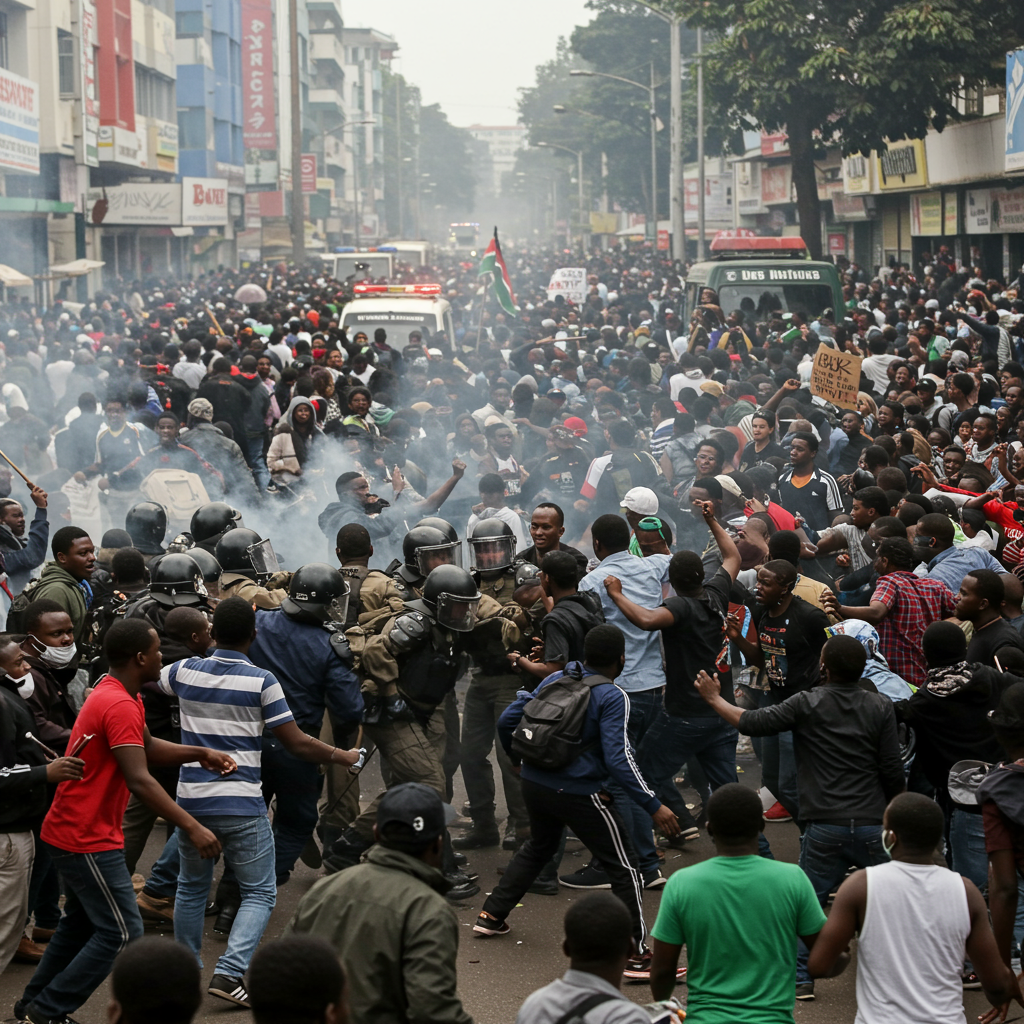Nationwide Protests Rock Kenya, Leaving Dozens Dead and Injured
Anti-government protests swept across Kenya on Wednesday, June 25, resulting in a grim toll of at least 16 fatalities and hundreds of injuries, according to human rights organizations monitoring the unrest. The demonstrations, which saw thousands take to the streets in major cities and towns, marked the somber one-year anniversary of previous deadly anti-tax protests.
Amnesty International Kenya and the government-funded Kenya National Commission on Human Rights (KNCHR) confirmed the death toll of 16. Rights groups reported that most casualties were caused by police actions, with at least five individuals confirmed to have been shot dead. A coalition of groups including the Kenya Medical Association stated over 400 people were injured, with 83 in serious condition and at least eight treated for gunshot wounds. Nairobi’s Kenyatta National Hospital alone admitted 107 injured, primarily with gunshot wounds from rubber or live rounds. Casualties reportedly included protesters, police, and journalists.
Deep-Seated Anger Fuels Demonstrations
While timed to commemorate the 2024 anti-tax rallies that left over 60 dead, this year’s protests were driven by a convergence of long-standing grievances against President William Ruto’s administration. Key factors fueling public anger include:
Police Brutality: Widespread resentment over excessive force and alleged extrajudicial killings by security forces. Recent incidents, such as the death of blogger Albert Ojwang in police custody and the shooting of an unarmed street vendor, have intensified outrage. Rights groups also reported concerns about police attacking peaceful protesters, sometimes alongside alleged “goons,” and the use of unidentified, plain-clothed officers.
Government Corruption: Deep disillusionment over perceived corruption scandals.
Economic Hardship: Frustration with the rising cost of living, high taxes, and a lack of promised economic improvements since Ruto took office in 2022. Although a controversial tax bill was withdrawn last year, the economic burden persists.
Disappearances of Critics: Rights groups have documented over 80 disappearances of government critics since last year, raising fears reminiscent of Kenya’s past dictatorial era.
Protesters in Nairobi chanted slogans like “Ruto must go” and carried placards honoring those killed in previous demonstrations.
Clashes Erupt Across Kenya
Demonstrations took place in at least 23 counties, including significant turnout in the capital Nairobi, the coastal city of Mombasa, and other areas like Kisumu, Nakuru, Nyahururu, Matuu, Kitengela, Kisii, and Nyeri. In Nairobi, authorities barricaded roads leading to key government buildings like Parliament and the president’s office with razor wire in anticipation of the march.
Eyewitnesses and reports described clashes as police used tear gas, water cannons, and batons to disperse crowds. Despite government warnings declaring Wednesday a “normal working day” and prohibiting unauthorized access to protected zones, thousands converged. Reports indicate police resorted to firing rounds to repel demonstrators, particularly in Nairobi.
The intensity of the clashes left parts of central Nairobi resembling a “war zone” the morning after, with widespread looting, burned businesses, and shattered glass reported, significantly impacting small and medium-sized enterprises. Protesters were seen using social media to coordinate and remember victims of past violence.
Government Actions and Criticisms
The government’s response included attempts to control the flow of information. The Communications Authority of Kenya reportedly ordered television and radio stations to stop broadcasting live coverage of the youth-led march, falsely claiming it violated laws and threatening regulatory action. Some channels were briefly taken off air but resumed coverage after a Nairobi court suspended the ban. The government also reportedly restricted access to the social media platform Telegram.
Civil society groups strongly denounced the media ban as “draconian” and unconstitutional, arguing that live coverage is crucial for accountability and deterring human rights violations by security forces.
President Ruto, while attending a burial outside Nairobi during the protests near his office, urged protesters not to “destroy” the country. He warned against the use of force or threatening police but stated that policing violations would be addressed through institutions. Kenya’s Ministry of Foreign Affairs also issued a statement urging mutual respect in diplomatic partnerships following a joint statement from Western embassies.
International Concerns
The embassies of the United States, United Kingdom, Canada, and other Western nations issued a joint statement calling on all parties to facilitate peaceful demonstrations, refrain from violence, and expressed concern over the use of plain-clothed officers in unmarked vehicles, stating it erodes public trust.
The events of June 25 underscore the ongoing tension and deep-seated dissatisfaction in Kenya, fueled by unresolved issues of police accountability, economic hardship, and governance. Rights groups are now calling for independent inquiries into the killings and the alleged excessive use of force by security forces, demanding accountability amidst a rapidly eroding public trust. The scale and violence of the protests highlight the urgent need for dialogue and reform to address the underlying causes of the unrest.



